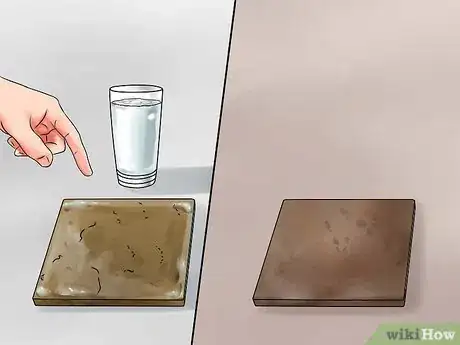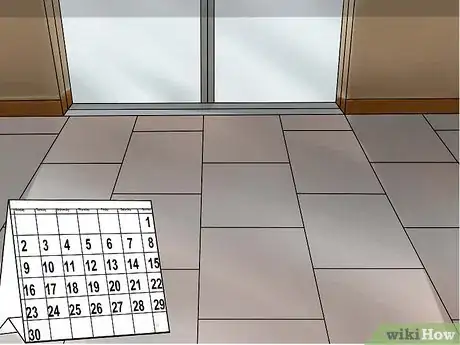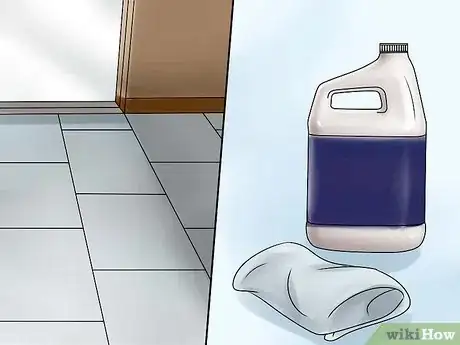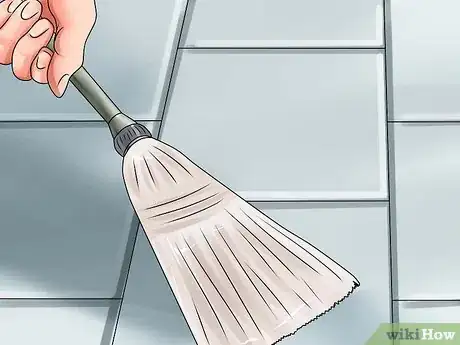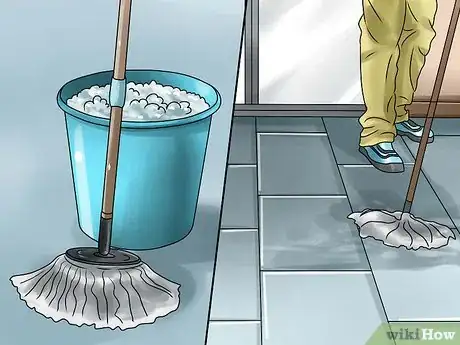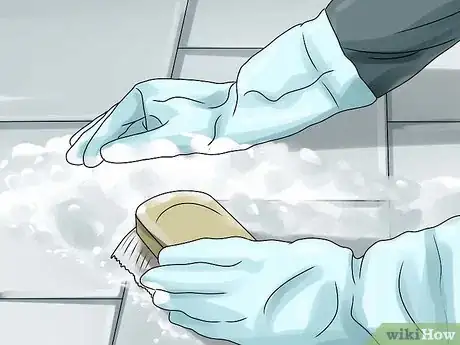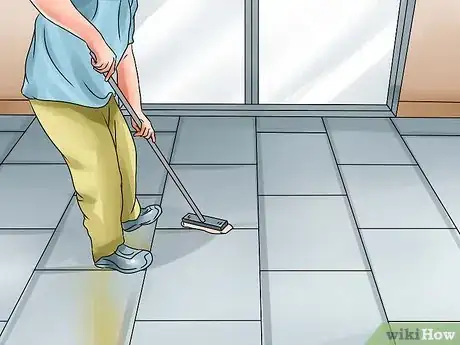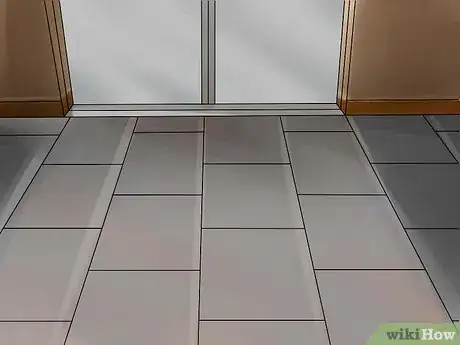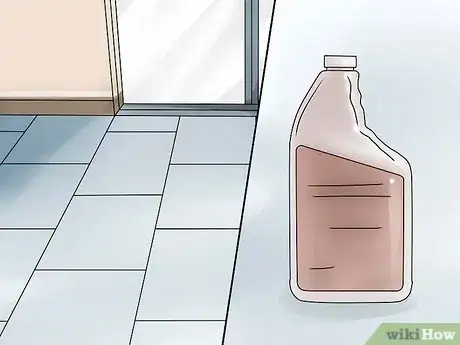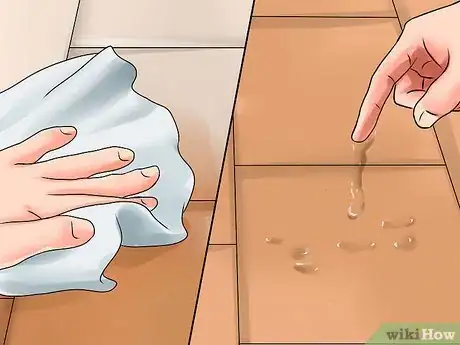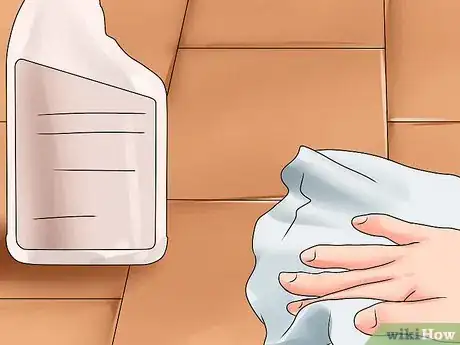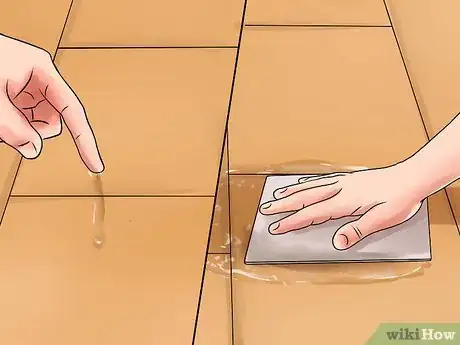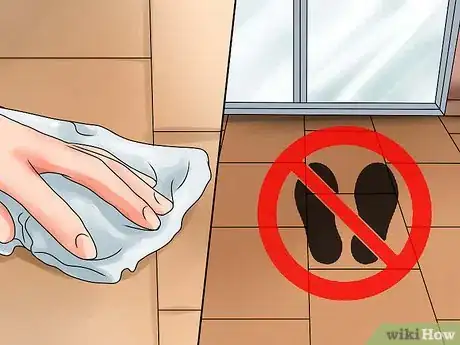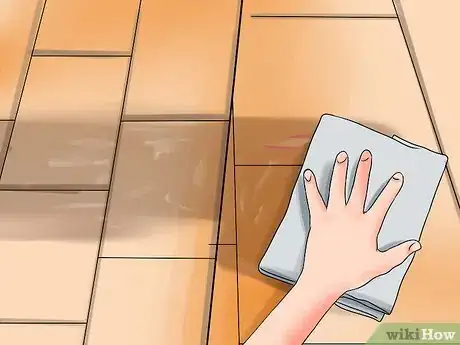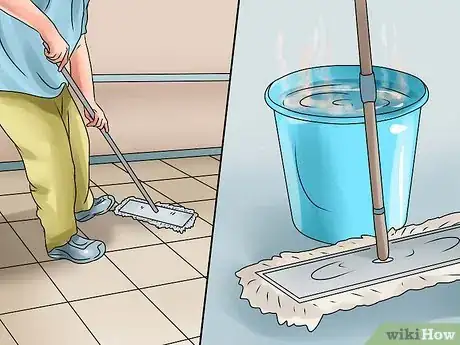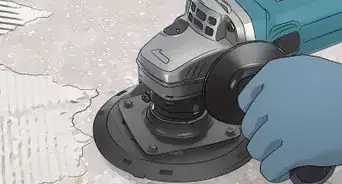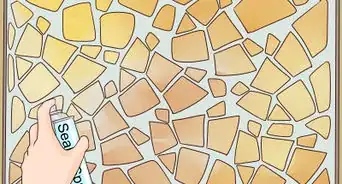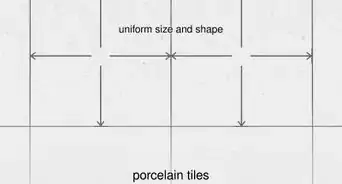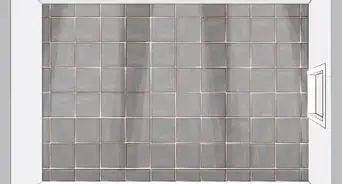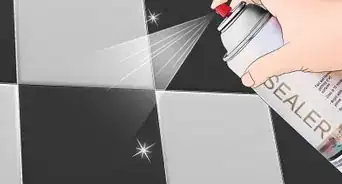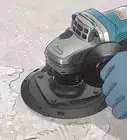This article was co-authored by Ahmed Mezil. Ahmed Mezil is a Cleaning Specialist and the CEO of Hellamaid, a cleaning service operating out of Southern Ontario, Canada. With over four years of cleaning experience, Ahmed and his insured and bonded Hellamaid cleaning staff specialize in house cleaning, post-construction cleaning, commercial cleaning, deep cleaning, and disinfection cleaning on various home/building surfaces. Ahmed holds a BASc in Mechanical Engineering from the University of Waterloo, a MASc in Mechanical Engineering from the University of Toronto, and holds a Professional Engineering license in Ontario, Canada.
wikiHow marks an article as reader-approved once it receives enough positive feedback. In this case, several readers have written to tell us that this article was helpful to them, earning it our reader-approved status.
This article has been viewed 154,955 times.
Travertine is a porous stone sometimes used in flooring, countertops, walls and back splashes. Sealing travertine won't prevent acidic material such as juice or wine from leaving marks, but it will make other stains and scratches less likely. Polished, glossy travertine is naturally resistant to non-acidic spills and may not absorb the sealer.[1] The instructions below include methods for testing whether the sealer is necessary.
Steps
Preparing the Travertine
-
1Test whether sealing is necessary. Polished travertine often doesn't need sealing, but you don't need to guess whether or not it's a good idea. It's easy to test whether sealing is required by dropping a few drops of water in a few inconspicuous areas. Let the water stand five to ten minutes, then blot dry. If the travertine stays darker in color for more than a few minutes, sealing is probably a good idea to protect it from other liquids that could leave a permanent stain.
-
2Wait at least two weeks after installation. If the travertine was recently installed, wait at least two or three weeks before sealing. This gives any moisture that may have gathered in the travertine during storage or installation time to evaporate.[2] Applying sealer may not be as effective if there is any moisture trapped deep in the travertine.Advertisement
-
3Strip old finish if necessary. If a travertine floor has an old coating of finish or wax that adds a separate, protective layer above the travertine, it will need to be removed with a floor stripper. Unlike floor finish or wax, an old sealer application would have just soaked into the stone, so there is no need to treat it.
- If the finish or wax has not become discolored, cracked, or otherwise worn out, and you like its appearance and feel, you may simply leave it on the travertine floor rather than applying a sealer. The finish or wax should provide protection against spills and scratches on its own.
-
4Remove dust from the travertine surface. Use a dust mop or soft broom to sweep travertine floors, then pick up remaining dust with a vacuum. Use a handheld duster to remove dust from other travertine surfaces such as countertops.
-
5Select a cleaning solution. Use any mild household cleaning solution, such as soapy water, or equal parts isopropyl alcohol and water. Avoid acidic cleaning solutions, such as Windex or vinegar, as these can etch permanent marks into the travertine. Remember to dilute the cleaning product if necessary, as instructed on the packaging.
- If the travertine is heavily soiled and mild cleaning products can't do the job, use an alkaline cleaning solution such as diluted bleach. These are not recommended except when absolutely necessary, as the harsh chemicals can mark the stone.
-
6Mop the cleaning solution onto the travertine. Use a mop to clean a travertine floor with the cleaning solution. Use a sponge or other small, clean object for travertine countertops and similar, smaller surfaces. Let the wet travertine sit for ten to twenty minutes to pick up as much dirt as possible.
-
7Scrub the travertine. Use a large push brush or deck brush to scrub floors, focusing on stained or dirty areas. Any stiff handheld brush can be used for smaller surfaces, or for nooks and crannies. Scrub until all dirt particles and stains are removed.
-
8Rinse with warm water several times. Rinse the travertine three or more times to remove the last traces of dirt and cleaning solution. If particles or dried cleaning product remains on the stone, the sealer may not be absorbed evenly.
- Rinse at least three times, then keep rinsing until the water has no traces of color, smell, or particles.
-
9Dry with a soft cloth. Wiping the rinse water off with a soft cloth, such as one made from cotton or microfiber, also helps pick up the last traces of dirt. You will be leaving the travertine to dry out fully in the next step, so you do not need to make the surface bone-dry. Just wipe up obvious puddles and damp spots as best you can.
-
10Let residual moisture dry overnight. The travertine needs to be completely dry before you apply the sealer. Leave it to dry overnight, or even for up to 72 hours if the stone is unpolished and in a damp area.
Sealing the Travertine
-
1Select a sealer. Look for a sealer specific to travertine, or at least suited for natural stone. Use a penetrating sealer, not a topcoat or surface sealer, since the latter kind are easily scuffed or flaked when applied over travertine.[3] Decide whether you want a sealer with a matte or gloss appearance, if applicable. Many stone sealers do not significantly affect the appearance of the travertine, but this is not universally the case.
- Water-based and solvent-based sealers are both safe to use on travertine. Water-based sealer is more environmentally friendly and may apply better to travertine in damp locations.
-
2Open doors and windows. Ensure that the space you are working in is well ventilated. The penetrating sealer can produce noxious fumes.
-
3Test the sealer. Rub in a small amount of the sealer in an inconspicuous area of the travertine. Let the sealer sit 24 hours. The wait is worth it to see if the final appearance and level of protection meets your standards. If you are not satisfied, find another sealer.
- To test the protective abilities of the sealer, after it has sat for 24 hours, apply a few drops of water to the sealed travertine. Blot after five or ten minutes. If the travertine does not return to its original, dry color within five minutes, the sealer may not provide enough protection. Keep in mind that you can apply multiple coats of sealer to provide additional protection.
-
4Use a soft cloth to evenly apply the sealant. Once you've tested a sealer and are satisfied with the results, rub it across the entire surface of the travertine. Use a soft cloth, or a lamb's wool applicator to save you time on large floors. Completely saturate the pores, but avoid leaving excess sealer on the surface of the stone.
-
5Wipe up puddles of sealer. If puddles form, wipe them up with a dry cloth or mop. Puddles of excess sealer may stain the stone if left to dry.
-
6Let the travertine dry, then apply second coat. Most travertine surfaces require at least two coats. You may follow the recommended number of coats listed on your sealer's label, or test the sealer once a coat is dry.
- To test the sealer, drop a few droplets of water in several locations on the travertine. Let sit for five to ten minutes, then blot dry. If the travertine doesn't return to its original, dry color within two or three minutes, apply another coat of sealer.
-
7Wait for the travertine to dry. Make sure that the sealer has been given plenty of time to soak in and dry before heavy traffic or use occurs. Optionally, you may buff the travertine with a cloth to speed up this process and reduce the chance of streaks from dried, excess sealer.
-
8Remove streak marks with more sealer. If the sealer left streaks or trails on the travertine as it dried, there is a simple way to remove them. Apply more sealer over the streaks to dissolve the dried crust, then buff the wet sealer with a cloth. Buff until all puddles and excess moisture have been removed to avoid a repeat of the original problem.
Keeping Travertine in Good Condition
-
1Keep mats or rugs near entrances. Abrasive grit can damage the stone surface of travertine floors. Keeping mats or rugs near the entrances, especially to the outside, helps remove some of this grit from the bottom of shoes and feet.
- Non-slip undersides are recommended to prevent the rug from slipping on the travertine.
-
2Clean travertine with a dry dust mop or duster. For regular dusting, use a dry dust mop or duster to avoid scratch marks from broom bristles. If you use a vacuum cleaner, make sure the wheels or frame aren't worn down and scraping the floor.
-
3Use water in regular washes. Mild household cleaning products can be used from time to time, but for regular washing, mopping with plain warm water is often enough and carries no risk of leaving marks on the travertine.
- Never use vinegar or other acidic cleaners, which can etch patterns even into sealed travertine.
Community Q&A
-
QuestionShould polished travertine tile be sealed? How many coats does it take?
 Paula KeslerCommunity AnswerYes. Travertine is porous. Seal it and let it dry. Test by pouring a small amount of water onto the sealed area. If the water beads, then you're finished. If the water soaks in, then repeat with another coat of sealer.
Paula KeslerCommunity AnswerYes. Travertine is porous. Seal it and let it dry. Test by pouring a small amount of water onto the sealed area. If the water beads, then you're finished. If the water soaks in, then repeat with another coat of sealer. -
QuestionIf I'm using a silicone sealant around the edges, should I seal the travertine first or after?
 Paula KeslerCommunity AnswerSeal the travertine before applying silicone.
Paula KeslerCommunity AnswerSeal the travertine before applying silicone. -
QuestionWhat if the sealer is too shiny, or when I scratch it a light film comes off? Can I buff the floor to remove the thin layer and remove some of the shine?
 Community AnswerYes, that is an easy fix. Also try lemongrass oil, a natural way to fill small scratches. In larger amounts it seals without a high shine.
Community AnswerYes, that is an easy fix. Also try lemongrass oil, a natural way to fill small scratches. In larger amounts it seals without a high shine.
Warnings
- Acidic substances such as citrus, vinegar, wine and soda etch (or erode) travertine, so it is important that these spills get cleaned as soon as possible.⧼thumbs_response⧽
- Do not use a surface or topcoat sealer on porous stone such as travertine. These can scuff and come off, or trap air bubbles and dirt. Penetrating sealers expand in the pores to become part of the stone while protecting it.⧼thumbs_response⧽
Things You'll Need
- Mop
- Neutral cleaning product
- Alkaline cleaning product (optional)
- Soft cloth
- Penetrating sealer
References
About This Article
To seal travertine, start by selecting a penetrating sealer made specifically for natural stone. Next, use a soft cloth to saturate the entire surface evenly with the sealer and wipe up any excess that pools on the surface to prevent staining. Then, let the first coat dry completely before applying a second coat. If you notice any streaks on the surface after the second coat dries, you can apply more sealer over the streaks and buff the wet sealer with a soft cloth to remove them. For tips on testing your sealer before application, read on!
